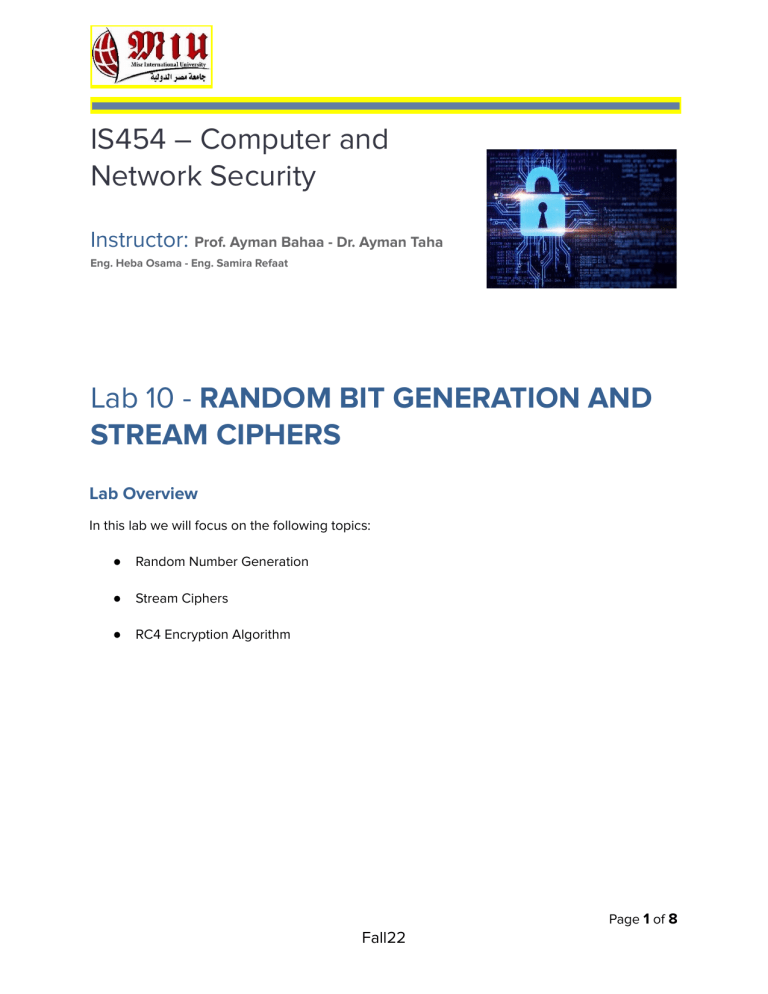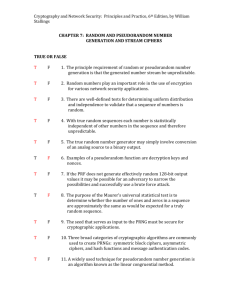
IS454 – Computer and Network Security Instructor: Prof. Ayman Bahaa - Dr. Ayman Taha Eng. Heba Osama - Eng. Samira Refaat Lab 10 - RANDOM BIT GENERATION AND STREAM CIPHERS Lab Overview In this lab we will focus on the following topics: ● Random Number Generation ● Stream Ciphers ● RC4 Encryption Algorithm Fall22 Page 1 of 8 Stream Cipher Structure: Fall22 Page 2 of 8 RC4 Encryption Algorithm: Description: ● stream cipher symmetric key ● Use two array, state and key: ○ 1. 256-byte state table. ■ State[256]=[ 0 .. 255 ] ○ 2. It has the capability of using keys between 1 and 2048 bits. ■ Key[1..2048] = [ ……. ] Algorithm: ● * Two phases ○ Key Setup 1. f = ( f + Si + Kg ) mod 4 2. Swapping Si with Sf ● Ciphering ( XOR) 1. i = ( i + 1 ) mod 4 , and f = ( f + Si ) mod 4 2. Swaping Si with Sf 3. t = ( Si + Sf ) mod 4 Random byte St Fall22 Page 3 of 8 TRUE OR FALSE 1. The principal requirement of random or pseudorandom number generation is that the generated number stream be unpredictable. 2. Random numbers play an important role in the use of encryption for various network security applications. 3. There are well-defined tests for determining uniform distribution and independence to validate that a sequence of numbers is random. 4. With true random sequences each number is statistically independent of other numbers in the sequence and therefore unpredictable. 5. The true random number generator may simply involve conversion of an analog source to a binary output. 6. Examples of a pseudorandom function are decryption keys and nonces. 7. If the PRF does not generate effectively random 128-bit output values it may be possible for an adversary to narrow the possibilities and successfully use a brute force attack. 8. The purpose of the Maurer's universal statistical test is to determine whether the number of ones and zeros in a sequence are approximately the same as would be expected for a truly random sequence. 9. The seed that serves as input to the PRNG must be secure for cryptographic applications. 10. Three broad categories of cryptographic algorithms are commonly used to create PRNGs: symmetric block ciphers, asymmetric ciphers, and hash functions and message authentication codes. 11. A widely used technique for pseudorandom number generation is an algorithm known as the linear congruential method. 12. A cryptographically secure pseudorandom bit generator is defined as one that passes the least significant bit test. 13. The security of Blum, Blum, Shub is based on the difficulty of factoring n. 14. The stream cipher is similar to the one-time pad with a difference being that a one-time pad uses a pseudorandom number stream, and a stream cipher uses a genuine random number stream. 15. The longer the keyword the more difficult the cryptanalysis. Page 4 of 8 Fall22 MULTIPLE CHOICE 1. A secret key for symmetric encryption that is generated for use for a short period of time is called a _________ . A. strategic key B. sequence key C. session key D. stream key 2. A __________ is used to produce a pseudorandom string of bits of some fixed length. A. PRF B. PRNG C. OFB PRNG D. TRNG 3. A source that is effectively random is referred to as __________ . A. an open source B. an entropy source C. a keystream D. a seed 4. A __________ takes as input a source that is effectively random. A. PRF B. BBS C. PRNG D. TRNG 5. A pseudorandom number generator takes as input a fixed value called the __________ and produces a sequence of output bits using a deterministic algorithm. A. seed B. fixed skew C. entropy source D. keystream 6. The best that can be done to determine if a PRNG generates numbers that have the characteristic of randomness is on the basis of multiple tests. These tests should seek to establish uniformity, scalability, and __________ . Page 5 of 8 Fall22 A. consistency B. authentication C. frequency D. sequencing 7. The __________ test is the most basic test of randomness and must be included in any test suite. A. frequency B. runs C. unpredictability D. Maurer 8. The Blum, Blum, Shub generator is referred to as a ____________ . A. TRNG B. OFB PRNG C. QRN D. CSPRBG 9. Two approaches that use a block cipher to build a PNRG and have gained widespread acceptance are: A. CTR mode and CFB mode B. CTR mode and OFB mode C. CBC mode and CFB mode D. OFB mode and ECB mode 10. A __________ uses a nondeterministic source to produce randomness. A. CSPRBG B. TRNG C. PRNG D. BBS 11. Various methods of modifying a bit stream to reduce or eliminate a bias have been developed. These are referred to as ___________ algorithms. A. backward B. deskewing Page 6 of 8 Fall22 C. forward D. keystream SHORT ANSWER 1. A __________ is a symmetric encryption algorithm in which ciphertext output is produced bit-by-bit or byte-by-byte from a stream of plaintext input. 2. Typically the __________ takes as input a seed plus some context specific values such as a user ID or an application ID. 3. Two criteria used to validate that a sequence of numbers is random are uniform distribution and __________ . 4. The most important and widely used stream cipher is __________ . 5. Two distinct requirements for a sequence of random numbers are unpredictability and __________ . 6. If the algorithm is good the resulting sequences will pass many reasonable tests of randomness. These numbers are referred to as ___________ numbers. 7. The __________ is drawn from the physical environment of the computer and could include things such as keystroke timing patterns, disk electrical activity, mouse movements, and instantaneous values of the system clock. 8. An algorithm that is used to produce an open-ended sequence of bits is referred to as a ___________ . 9. The purpose of the __________ test is to determine whether the number of runs of ones and zeros of various lengths is as expected for a random sequence. Page 7 of 8 Fall22 10. A stream of pseudorandom numbers should exhibit two forms of unpredictability: forward and __________ . 11. __________ algorithms are designed specifically and solely for the purpose of generating pseudorandom bit streams. 12. In a stream cipher structure a key is input to a pseudorandom bit generator that produces a stream of 8-bit numbers that are apparently random. The output of the generator, called a ___________ , is combined one byte at a time with the plaintext stream using the bitwise exclusive-OR operation. Problems: Encrypt the word “HI” using the RC4 encryption algorithm. with: ● ● ● i=0, f=0, g=0 S[ ]=[ S0, S1, S2, S3 ] = [ 0, 1, 2, 3 ] K[ ]=[ K0, K1 ] = [ 2, 5 ] Fall22 Page 8 of 8


